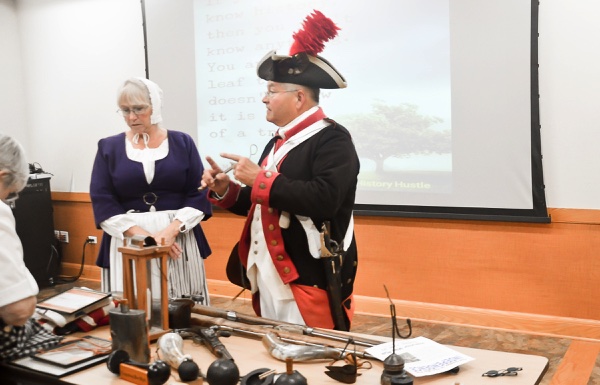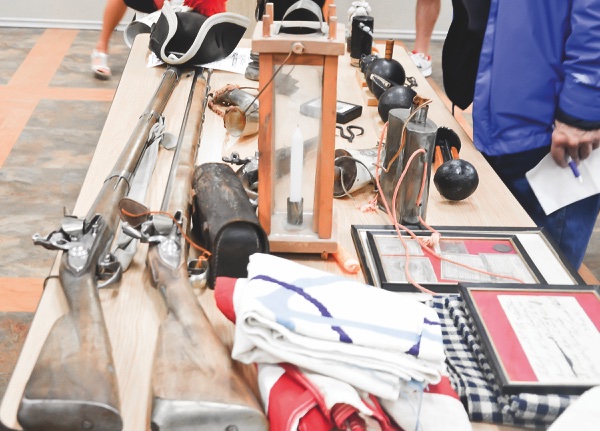
Mike and Cindy Ptak in full costume. (Photo by Christine Such/Sun Day)
Can you guess what this picture is? If you attended the presentation by Mike Ptak on June 30 on “The Soldier in The War for Independence,” you know the answer.
Ptak has been a Premier American Revolutionary War Reenactor for 35 years. He and his wife, Cindy, and their children, Sarah and Steve, lived for many years during the summer in tents throughout the Midwest. They provided a window view into how men and women lived during the Revolutionary War and how those individuals shaped our history. The families participating provided attendees not only a view of camp life but also battle demonstrations of the fight for our independence.
Mike, decked out in his Revolutionary uniform, started his presentation, “No one woke up on the 4th of July with the idea to break away from England.”
The idea of breaking away from England grew from informal meetings at pubs akin to “’Drinks on the Driveway” here in Sun City,’” Mike informed the group. A Brit drinking tune that was sung at the meetings that rallied the people became our First National Anthem, “Chester.”
Cindy, dressed in the attire of women during that period, gave a choral rendition of the first national anthem of the United States. Eighteenth-century women dressed in layers and wore caps to keep their hair clean. Not only was “it hot, but it was hard to hear with the cap on,” she confided to the audience.
“I am glad I have this wool coat on today in this heat,” Mike joked. His uniform is a blue wool coat is part of a suit of regimentals. It has a buff wool rise-and-fall collar, buff cuffs and lapels, and buff lining; there is a row of metal buttons on each lapel, as well as on each cuff that Mike made himself.

Items used in the Revolutionary War on display, during presentation. (Photo by Christine Such/Sun Day)
The item pictured is a brick of tea. On the night of December 16, 1773, the Sons of Liberty boarded three ships in the Boston harbor and threw over 300 chests that contain the tablets of tea.
Mike had many other artifacts to share during the presentation. One of those was a horn that Mike had scrimshawed himself “PRO PATRIA, The First Man That Either Distributes Or Makes Use Of Stampt Paper, Let Him Take Care Of His House, Person, And Effects.” He explained this phrase was meant to intimidate anyone who tried to enforce and distribute the stamps.
Mike spoke of an unseen killer present in the early years of the American Revolution, smallpox. He pulled a small sprig of evergreen from his hat and disclosed, “The soldier wore a Sprig of Evergreen in their hat to indicate that they had received the inoculation.”
Holding a weapon, Mike explained the origin of a much-used phrase, “I bought this Lock, Stock, and Barrel.” It means that he bought the entire weapon.
“The lock is the firing mechanism. The stock is the wooden butt-end of the gun: and the barrel,” he said, pointing at a barrel of the gun.
“Do you know what white chimneys mean?” Mike asked while displaying a slide with homes painted with white chimneys. These were called Tory chimneys, and it was a secret sign that Loyalists occupied the house. Loyalists remained loyal subjects of the British crown during the American Revolutionary War. Next time you drive through New England, try to find the white chimneys and think of what a history that home has!
The pictured flag Cindy and Mike are holding up “…was the flag of the First Pennsylvania Continental line. It’s the flag that had been with General Washington crossing the Delaware River and at Yorktown. The Latin inscription upon it is ‘I will not be conquered.’ It is what had been ordered by the Continental Congress at the time, both a regimental flag and a morale flag.” The flag that usually is depicted in the paintings of Washington crossing the Delaware is incorrect, the Ptaks said.
As Mike received the signal that his time was up, everyone was still seated and captivated by the night’s presentation.
The Ptaks’ next presentation, “Patriots in Peticoats,” will be on September 29.




